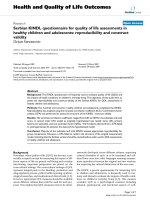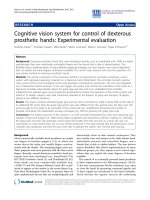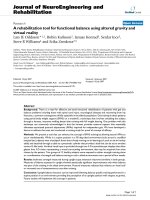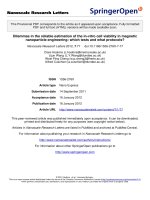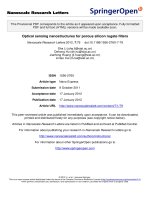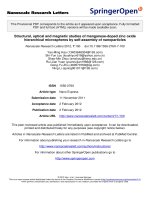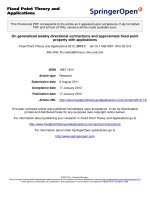Báo cáo toán học: " Reverse Engineering Technologies for Remanufacturing of Automotive Systems Communicating via CAN Bus" pot
Bạn đang xem bản rút gọn của tài liệu. Xem và tải ngay bản đầy đủ của tài liệu tại đây (855.03 KB, 14 trang )
RESEARCH Open Access
Reverse Engineering Technologies for
Remanufacturing of Automotive Systems
Communicating via CAN Bus
Stefan Freiberger
*
, Matthias Albrecht and Josef Käufl
Abstract
Nowadays, as mechatronic and electronic systems have found their way into vehicles, the technological
knowledgebase of traditional remanufacturing companies erodes rapidly and even the industrial principle of
remanufacturing is at risk. Due to the fact that modern cars incorporate up to 80 of these mechatronic and
electronic systems that are communicating with each other e.g. via the vehicle controller area network (CAN),
remanufacturing of these automotive systems requires innovative reverse engineering knowhow, methodological
innovations and new technologies, especially focusing on the tasks testing and diagnostics of systems and their
subassemblies. The European research project “CAN REMAN”, conducted by Bayreuth University in cooperation with
two other universities and eight industrial partners, focuses on these nee ds in order to enable companies to
remanufacture modern automotive mechatronics and electronics with innovative reverse engineering skills as well
as to develop ap propriate and affordable testing and diagnostics technologies.
In order to operat e and test the mechatronic device with CAN interface outside the vehicle environment, an
appropriate simulation of the vehicle network and all connected sensors of the device under test (DUT) is essential.
This implies an electrical analysis of the connector s of the DUT, a content-related analysis of the CAN-bus, a sensor
hardware simulation and a CAN-bus simulation.
All electrical measurements and results were taken using conventional multimeters or oscilloscopes. The CAN-bus
analysis and simulations were conducted using the Vector Informatics software tool “CANoe” (Version 7.1) and a
suitable CAN-bus hardware, e.g. the CANcardXL and the IOcab8444opto. All hardware simulations were executed
with a conventional wave form generator or a microcontroller evaluation board (Olimex AVR-CAN) and an
appropriate electric setup.
In order to initially readout the failure memory and to investigate the diagnostic communication of the DUT,
garage testers such as “Bosch KTS 650” or “Rosstech VAG-COM” were used.
The results of the project are application-orientated methods, test benches and skills for remanufacturing
companies to find out the working principles of the CAN-bus communication between automotive mechatronic
and electronic systems within vehicles.
The knowhow presented in this article enables remanufacturing companies to remanufacture modern automotive
mechatronic and electronic systems which are communicating via the CAN-bus and similar communication types.
Keywords: Remanufacturing, Mechatronics, Electronics, CAN-bus, Reverse Engineering, Testing, Diagnosis, Vehicle
Network Topology
* Correspondence:
Chair of Manufacturing and Remanufacturing Technology, Bayreuth
University, Universitaetsstrasse 30, 95447 Bayreuth, Germany
Freiberger et al. Journal of Remanufacturing 2011, 1:6
/>© 2011 Freiberger et al; licensee Springer. This is an Open Access article distributed under the terms of the Creative Commons
Attribution License (http://creativecomm ons.org/licenses/by/2.0), which permits unrestricted use, distribution, and reproductio n in
any medium, provided the original work is prop erly cited.
1. Introduction
Raising requirements on occupant safety and comfort on
the one hand and the introduction of new emission reg-
ulations on the other hand, forces the automotive man-
ufacturers to enhance their products continuously. In
order to achieve these improvements, electronic systems,
based on microcontrollers, have found their way into
modern cars and they contributed considerably to many
new advantages in terms of safety and comfort such as
Electronic Stability Program (ESP), Anti-lock Brake Sys-
tem (ABS), Parking Assist System (PAS), Electro
Hydraulic Power Steering ( EHPS) or Electro Assisted
Steering (EAS). Nevertheless, the new trend of moderni-
zation has an immense impact on the remanufacturing
business. It can be seen that new b ranches in electronic
remanufacturing arise. In contrast to that, the knowhow
of traditional remanufacturing companies has eroded
rapidly and even the industrial principle of remanufac-
turing is at risk [1]. Due to t he fact that modern cars
incorporate up to 80 of these mechatronic and electro-
nic systems that are communicating with each other e.g.
via the CAN-bus, remanufacturing of these automotive
systems requires innovative reverse engineering kno-
whow, methodological innovations and new technologies
especially focussing on the tasks testing and diagno stics
of systems and their subassemblies. Since, traditional
remanufacturing companies do not have much capacity
to build up the appropriate knowhow, the Chair of
Manufacturing and Remanufacturing Technologies at
Bayreuth University assists these companies in reverse
engineering, as well as finding new methodologies and
technologies for remanufacturing [2,3].
In the following chapters, reverse engineering methodol-
ogies, technologies and results for automotive components
will be presented on the example of an EHPS pump. The
results have been obtained within the Europea n research
project “CAN REMAN” which is conducted by Bayreuth
University, Linköping University (Sweden), the University
of Applied Sciences Coburg, Fraunhofer Project Gro up
Process Innovation and eight industrial partners. The tar-
get of this project is to enable independent aftermarket
(IAM) companies to remanufacture modern automotive
mechatronics and electronics with innovative reverse engi-
neering skills as well as to develop appropriate and afford-
able testing and diagnostics technologies [4]. The
described, close to industry results, will contribute to the
remanufacturing research theory by the upcoming PhD-
thesis of engineers of the Chair of Manufacturing and
Remanufacturing Technology.
2. Automotive Mechatronics Change Today’s
Remanufacturing
The term “mechatronics” was formulated in 1969 in
Japan and it is an artifice that describes a system which
combines mechanics, electronics and information tech-
nologies. A typical mechatronic system gathers data,
processes the information and outputs signals that are
for instance converted into forces or movements [5].
2.1. Technological Change of Vehicles
Automotive parts should not longer be seen as isolated
standalone applications with few mechanical and electri-
cal inputs and outputs. Now, they have the capability to
communicate to each other and to share the same infor-
mation. Subsequently, the communication of the differ-
ent automotive subsystems helps the original equipment
manufacturers (OEMs) to reduce weight and cost by
sharing the same sensors and reducing cable doubling
(cable length) in modern vehicles. For the driver the
network and communication within the car remains
invisible and he feels the car behaving like ten years ago
despite of some additional comfort functions. Figure 1
demonstrates the radical shift in the automotive techno-
logical development.
But if we take a closer look, now adays modern vehi-
cles resemble more or less a distributed system. Several
embedded compute rs - often referred to electr onic con-
trol units (ECUs) - communicate, share information and
verify each other over the vehicle network. One of the
commonly used communication networks in vehicles is
the C AN-bus. Within this network structure, each con-
trol unit has at least one unique identifier (ID) on which
it broadcasts messages that again incorporate different
signals and information [6]. E asily speaking, in case of a
missing or faulty participant in the network, all other
controllers will notice the participant as they have a lack
of information. The lack of information or errors on the
CAN-bus can force other systems to operate in a “safe
mode” or cause that these systems never start their
operation. In reverse, a controller not connected to the
specific vehicle network will not start its regular opera-
tion patterns.
2.2. Difficulties for Remanufacturers
As stated before, the introduction of electronic networks
into modern cars entails enormous problems for rema-
nufacturers. Modern electronic and mechatronic vehicle
components cannot be tested as easily as traditional
electrical and mechanical ones [7-9]. While it was
usually sufficient to link electrical systems to the power
supply (battery ), modern mechatronic and electronic
systems gather a lot of information from the vehicle
environment and driving conditions using plenty of sen-
sors and the CAN-bus network of the vehicle. As a con-
sequence, connecting all sensors and the power plug to
the DUT is insufficient unless the device is connected to
the network of a real car or an adequate simulation of
the communication in the vehicle.
Freiberger et al. Journal of Remanufacturing 2011, 1:6
/>Page 2 of 14
Following these statements, the key for successful
remanufacturing and testing of a certain automotive sys-
tem lies in the simulation of the complete network com-
munication in the vehicle. In each case, the car ma trix
(CAN database) of the specific vehicle model is required
to build a simulation of the CAN communication in a
vehicle. However, the OEMs will no t release any infor-
mation on the communication parameters to non-OEs
and therefore they will not support the independent
remanufacturing business. As a consequence, the inde-
pendent remanufactures - onto which this paper focus es
- have to do a lot of reverse engineering themselves or
in cooperation with others i n order to design their
remanufacturing process chain and to come up with test
solutions to ens ure the quality of their products [10-12].
These reverse engineering activities focus on the system,
its components, the system behavior in the vehicle and
the vehicle CAN-bus communication.
2.3. The Remanufacturing Process Chain for Automotive
Mechatronics
Following the previous aspects, the state-of-the-art pro-
cess chain for remanufacturing, needs to be reconsid-
ered when it comes to mechatronics, as shown in Figure
2. Regarding the process steps, disassembly, cleaning
and reassembly, great progress has been made on
mechanic systems, as it can be found in the literature
[13-16]. This progress on the mechanical systems can
also be transferred to the mechanic components inside
of mechatronic systems. However, the diagnostics and
testing differs to a certain extent from the traditional
(final) testing of mechanics, as it has already been dis-
cussed before. In addition to this, it was found that a lot
of failures of parts and its subassemblies can only be
detected or isolated with a test of the completely
assembled mechatronic system [2,17], e.g. by utilization
of the onboard-diagnostics and readout of the fault
memory inside a mechatronic system. This means that
the process chain for remanufacturing of mechatronic
systems should be extended by an additional first step
as it is shown in Figure 2.
In the initial entrance diagnostics of the system to be
remanufactured all communication patterns have to be
reverse engineered in order to simulate the vehicle net-
work and get access to the fault memory of the system.
An appropriate vehicle network simulation will also pre-
vent new fault memory records to be stored in the
DUT.
3. Reverse Engineering an Automotive
Mechatronic System
The term “ reverse engineering“ has its origin in the
mechanical engineering and describes in its original
meaning the analysis of hardware by somebody else
Figure 1 Development in automotive maintenance [3].
Freiberger et al. Journal of Remanufacturing 2011, 1:6
/>Page 3 of 14
than the developer of a certain product and without the
benefit of the original documentation or drawings. How-
ever, reverse engineering was usually applied to enhance
your own products or to analyze the competitor’spro-
ducts [18]. According to Cifuentes and Fitzgerald
(2000), an analog term is “reengineering“ (of software)
which does not refer to the process of analyzing soft-
ware only, but which a lso intends to translate software
into a new form, either at the same or a higher level of
abstraction. In addition to this, the two authors sum-
marize the different types of software reverse engineer-
ing. It can be differentiated between black and white
Figure 2 Adopted remanufacturing process chain for mechatronics [20].
Freiberger et al. Journal of Remanufacturing 2011, 1:6
/>Page 4 of 14
box reverse engineering. While black box reverse engi-
neering only looks at the behavi or of a program and its
documentation (if it’s available) without examination of
the internals of the program, white box reverse engi-
neering involves looking at the internals of a program
so that its working can be understood [19].
Chikovsky and Cross (1990) describe reverse engineer-
ing in the context with software development and the
software life cycle as an analysis process of a system, in
order to identify the system (sub-) components, to
investigate their interaction and to represent the system
at a higher level of abstraction [18]. In this context, they
also clarifie the terms “redocumentation” and “design
recovery”.
“Redocumentation” is the generation or revision of a
semantically equivalent description at the s ame abstrac-
tion level. This means, that the results are an alternative
representation form for an existing system description.
However, redocumentation is often used in the context
of recovering “lost” information [18].
The term “design recovery” defines a subset of reverse
engineering that includes domain knowledge, e xternal
information ( of third parties) and conclusions addition-
ally to the origi nal observations and an alyses in order
derive meaningful abstractions of th e system at a higher
level [18].
Overall, reverse engineering of software in the f ield of
software development fo cuses on the following six tar-
gets [18-20]:
- Coping with the system complexity
- Generation of alternative views
- Recovery of lost information
- Detection of side effects
- Synthesis of higher abstractions
- Facilitation of reuse
Thesetargets,thathaveoriginallybeendefinedfor
software reverse engineering, can also be transferred to
a certain extent to the reverse engineering of automotive
mechatronic systems and hence to the remanufacturing
of these systems.
First, remanufacturers will have to cope with the com-
plexity of mechatronic systems as stated before. “Cope”
means in t his context, that it must be possible to oper-
ateanautomotivemechatronic system independently
from its original environment (the vehicle).
Second, universal taxonomies have to be detected in
order to transfer the gai ned knowledge to similar
mechatro nic systems or to other variants of the syste m.
Espe cially the high degre e of variation of similarly look-
ing mechat ronic systems and control units makes it dif-
ficult for the remanufacturers to manage the complexity
of automotive components that usually differ by a slight
detail [21].
Third, recovery of missing, rather than lost, informa-
tion will be one of t he most important aspects for the
remanufacturing.
The following chapter demonstrates how a reverse
engineering analysis can be conducted for an automotive
mechatronic system.
4. Analyzing an Automotive System in Five Steps
After a reference system (a reference system in this case
is a commonly used automotive subsystem; for example
an electro-hydraulic power steering pump) for the analy-
sis has been chosen it is necessary to procure at least
one, ideally brand-new, system to grant correct func-
tionality, for all following investigations. In order to ana-
lyze the system in its normal working environment, the
original vehicle, in which the reference system com-
monly is built in, should be procured as well.
This investment might be unavoidable, because a
mechatronic system communicating via CAN, detached
from all other vehicle communication will not work
anyway, because essential input information, transmitted
viaCAN,ismissingotherwise(refertochapter2).In
this case it is very difficult to understand the ECU com-
munication and put up the system into operation iso-
lated from the vehicle.
A cheaper way to investigate the communication
between vehicle and refe rence system is to create a
CAN recording using a software tool such as “ CANoe”
from Vector Informatics. This tool allows easily record-
ing of the complete vehicle communicatio n for instance
while doing a test drive with a vehicle that may be avail-
able only once. But this procedure requires careful plan-
ning prior the test drive is carried out, in order to
record every driving condition which is needed for
further analyses without having the vehicle available.
Whatever strategy is chosen, it is essential to figure
out which input information (CAN data) is necessary to
start, operate and control the system.
The following subsections will describe the five most
important steps of the analysis process more in detail.
4.1. Electrical Wiring
After having obtained a referenc e system, it is essential
to know the pinout of all connectors of the system.
Therefore, the very first step is to find out which pin
belongs to which wire and signal.
First of all, the power connector (ground and positive
terminal), including ignition, must be identified. One
opportunity to obtain this information is the utilization
of wiring diagrams or similar c redentials. If such docu-
ments are not available, for example a visual inspection
of the connectors and wire harness in the vehicle or
continuity measurements can be beneficial.
Freiberger et al. Journal of Remanufacturing 2011, 1:6
/>Page 5 of 14
Afterwards, it is indispensible to identify the CAN
connection pins. These can easily be recognized by
inspecting the cable harness (in most cases two twisted
wires, but single wire CAN connection is possible, too)
or by measuring a terminating impedance of 60 Ω
between to cables.
Finally, all connectors for sensors and actuators (aux-
iliary power and sensor/actuator signal) must be known
as well to go further in the analysis process.
4.2. Vehicle Network Topology
The investigation of the structure of all bus systems in
the vehicle is placed in front of the proper CAN-bus
analysis step. It is necessary to determine how many
(CAN-bus) networks are established and in which net-
work the refere nce system is located. Additionally, the
network speed, the presence of a separate diagnosis net-
work (e.g. K-Line), and all ECUs of the specific networks
must be found out, especially those ECUs that provide
essential input as mentioned before. Furthermore, possi-
ble gateway ECUs, which are linking different networks,
should be identified.
A feasible solution to gain this information can be for
example a web inquiry, documents from the manufac-
turer of the vehicle or the system, third party documents
or technical journals (e.g. ATZ, MTZ ).
4.3. CAN Bus Communication
In order to understand the vehicle communication more
in detail, all ECUs and its associated CAN message IDs
must be determined. For this purpose CANoe can be
used. First of all, a physical connection to access the
CAN-bus using CANoe has to be installed in the vehi-
cle, ideally nearby the reference system ECU. With the
“trace functionality” of CANoe the bus communication
and all CAN messages of all ECUs can be displayed
easily (Figure 3). Beside of the CAN IDs, t he cycle time
and the length of each message can be anal yzed. This
information is relevant later on for a rest bus simulation
of all participating ECUs to ensure correct functionality
of the reference system.
The assignment of CAN ID and the associated ECU is
more difficult. In the following, two options are
described in detail.
One possibility to gather this information is to
record the CAN communication initially with all ECUs
connected to the bus using CANoe. Afterwards, each
ECU is disconnected from the bus one after another
and a CAN trace is stored again. Next, all recordings
are compared to each other. Those IDs that are miss-
ing in the recording can be assigned to the discon-
nected ECU.
Another appropriate and more sophisticated way is to
locate all ECUs which provide rel evant data on the
CAN bus and to se parate the CAN wires out of the
cable harness. Each end of the CAN wires in the vehicle
must be connected to a computer via CAN hardware.
Afterwards, a kind of software gateway (Figure 4) is
installed in between the DUT and the other ECUs using
CANoe and a simple CAPL (CAN Access Programming
Language) program.
By this means, it is now possible to detect the mes-
sages on the bus as well as the transmit direction -
receive or transmit. This step is repeated for each ECU
which provides relevant input data for the ref erence sys-
tem. Obviously, t he time exposure for this kind of
CAN-busanalysisismuchhigherduetofactthatthe
gateway has to be pla ced in be tween every ECU which
is connected to the CAN network. The higher the com-
plexity level of the reference system (more inputs), the
more time is needed to identify all ECU messages which
transmit relevant data via CAN.
The second way is more satisfying, although it may be
more time-consuming than the first one. The first
option offers a good overview of all CAN messages and
its original ECU, but it may be fault-prone and incom-
plete. No matter which way is chosen, the result is a
complete CAN message structure. Both ways are
targeting.
But not all identified messages are relevant for the
DUT. Som e are not recognized by the DUT and can be
disregarded for further investigations. By adding filters
for single messages i n the gateway CAPL program or
simply disconnecting whole ECUs from the network, an
empty fault me mory of the DUT will reveal unnecessar y
messages/ECUs and hence reduce data complexity.
Hereby, an external garage tester can be used in most
cases in order to readout the fault memory and in order
to determine whether a failure was caused by removing
certain data information.
After having identified the relevant CAN m essages, it
is inevitable to examine the message data bytes i n detail
to determine the physical signals. This can be achie ved
by generating physical inputs manually (e.g. open the
throttle, drive, break ) and observe the particular CAN
messages as well as its bytes in parallel. After that, a
correlation between a CAN message, its CAN data and
a physical input value can be established.
Having performed the steps above, it is possible to
setup the desired restbus simulation for the reference
system.
4.4. Sensors
Besides the CAN data, analog inputs of sensors and ana-
log outputs of actuators are important in or der to
ensure correct functionality of the reference system.
Therefore, each sensor and nearly each actuator has to
be analyzed and simulated, too.
Freiberger et al. Journal of Remanufacturing 2011, 1:6
/>Page 6 of 14
The sensors can be analyzed using an oscilloscope and
a multimeter in order to characterize current consump-
tion, supply voltage and signal transmission. Typically,
sensor output signals are analog to:
- Current/voltage, amplitude
- Frequency/cycle time
- Pulse width/duty cycle
Or they are discrete in the following forms:
- Binary
- Multi-staged (different scaled)
- Multi-staged (equidistant) ® digital
For the simulation, the measured values must be
interpreted and emulated. For exa mple, the internal
resistance of a sensor (load) can be calculated from the
sensor current consumption. Afterwards, the presence
of the sensor can be simulated using a (simple)
resistor.
The simulation of the sensor signal can be realized
using a waveform generator, an analog circuit, a micro-
controller or a combination of them, depending on the
signal characteristics.
4.5. Diagnostics
Finally, to test the reference system completely detached
from the vehicle, it i s necessary to know how the diag-
nosis communication works in order to check the fault
memory and to read internal sensor information of the
ECU (e.g. for temperature).
First, the applied protocols for transport and applica-
tion layer must be identifi ed. Often, standardized com-
muni cation protocols for ECU diagnostics are used (e.g.
ISO TP, KWP2000 or UDS). In some cases OEMs use
proprietary self-developed keyword protocols (e.g.
KWP1281). Thus, it is more difficult to establish a
Figure 3 CANoe trace with all CAN IDs (messages) that are sent by the different ECUs within the VW Polo (the first column shows the
current time stamp in seconds, the second column shows the cycle time in seconds, the third one displays the IDs and the last
column contains the data bytes of each message).
Freiberger et al. Journal of Remanufacturing 2011, 1:6
/>Page 7 of 14
diagnosis connection to the reference system because
the protocol specification is unkn own to the remanufac-
turer. Hence, a detailed analysis of the CAN or K-Line
communication during a diagnosis session is essential.
Sophisticated reverse engineering capab ilities are neces -
sary in orde r to analyze, understand and re create such a
diagnosis communication. The message IDs, used for
the communication, must be investigated independently
by observing the diagnosis communication with CANoe.
If the CAN IDs and protocols a re known, the diagnose
communication can be reproduced for example in
CANoe using the CAPL environment.
After a remanufacturing company has accomplished
all mentioned steps for the reference system, it is able
to operate this system detached from all analog (sensor
signals) or digital (CAN) inputs.
Finally, a test bench can be developed for entrance
and final testing in series production scale.
5. Example: Remanufacturing of an Electro
Hydraulic Power Steering (EHPS) Pump
An electro hydraulic power steering pump is a rotating
oil pump driven by an electro motor. The pump con-
verts electric power to hydraulic power. The hydraulic
power is used to reduce the force the driver needs to
steer the car. Most steering assistance is needed at low
driving speeds, maybe for parking, which makes it
necessary that the EHPS pump has information about
the actual driving speed. That info rmation is communi-
cated via CAN-Bus.
The f ollowing six steps describe the reverse engineer-
ing process on the basis of an EHPS pump that is used
in a VW Polo which is seen in Figure 5.
5.1. Physical Analysis and Electrical Wiring of the EHPS
At the beginning, the EHPS has to be perceived as a
black box with inputs and outputs. Because of the
mechanical design and the general function of a hydrau-
lic power steering, the output can be determined as the
flow rate of the fluid [20]. The inputs are composed of
an information about the internal combustion engine
state (running or not running) and direct or indirect
information about the necessary oil flow rate.
Togetafirstoverviewabouttheelectricalconnec-
tions of the device, a reference system (in this case the
EHPS of t he VW Polo - see Figure 6)) was completel y
disassembled. Large connector pins were good indicators
for the general power supply by reason that the power
consumption of the electric motor is supposed to be
high. The ground pin of this connector was found by
searching for a direct linkage between those pins and
the ground plate of the circuit board. The other cable
Figure 4 CANoe as software-gateway.
Freiberger et al. Journal of Remanufacturing 2011, 1:6
/>Page 8 of 14
on the connector is the posit ive power supply. At thi s
point, the connection of the steering angle sensor,
which is directly mounted on the steering shaft, was dis-
regarded. The third connector contained three ca bles.
Twoofthemweretwistedinthefollowingcablehar-
ness. That was a perfect indication for CAN cables. The
CAN-high cable rises from 2.5 V to 3.5 V and the
CAN-low cable falls from 2.5 V to 1.5 V during active
communication. When operating the vehicle, the last
cable was on 12 V level and therefore it was assumed to
be the signal for “ ignition on”. At this point the electri-
cal analysis of the device was completed.
5.2. Vehicle Network Topology
On the example of the VW Polo EHPS, all relevant
ECUs for operating the DUT have to be in the same
CAN-bus network (Figure 7). Unfortunately, the CAN
bus is not linked to the on-boar d diagno sis (OBD) con-
nector of the test veh icle, whereas usually selected CAN
bus data is also accessible through this connection.
Therefore, the CAN wires in between of the EHPS and
the rest of the vehicle were separated in order to get
access to this network for further investigations.
Assigning single messages/IDs to ECUs has simply
been done by disconnecting single ECUs and locating
missing messages/IDs. By a parallel readout of the inter-
nal fault memory of the DUT, relevant ECUs or single
messages have been found.
5.3. CAN Bus Communication Investigations
This step can always be split into two parts. The first is
the a nalysis of the communication in order to filter out
and understand the relevant messages for the EHPS sent
by other ECUs. The second is the simulation of the
necessary CAN communication, which is called “rest-
bus” in the following.
First, the start signal, transmitted to the EHPS via
CAN bus, must be discovered as described in step 2.
Therefore, a recording of the in-car CAN communica-
tion was made at a stationary test with well defined and
reproducible conditions. After that, the recording was
replayed to the test device outside the car and it started
Figure 5 Examination of the CAN Reman test vehicle.
Freiberger et al. Journal of Remanufacturing 2011, 1:6
/>Page 9 of 14
its operation. Next, CAN messages were successively fil-
tered out until the motor of the test device stopped.
Hence, the last filtered message contained some kind of a
start signal. Having performed in depth analyses, this sig-
nal was identified to be the RPM signal of the internal
combustion engine. In order to eliminate or to find other
input parameters, the same study was carried out using a
recording of a real-road test. It was found that the vehicle
speed is another input parameter for the EHPS.
Second, required input parameters were simulated with
CANoe. Using a third party diagnosis garage tester
(Bosch KTS 650), it was discovered that the fault memory
of the external EHPS can only be erased when at least the
presence of the missing messages of the in-car communi-
cation is simulated, too. This simulation of messages
with and without data content is called restbus.
At this point the EHPS can completely be operated
outside the car, but with a real steering angle sensor.
5.4. Simulation of Sensors
In order to operate the EHPS in a completely simulated
environment, the angular ve locity sensor had to be
simulated.
Analog to step one, VCC and GND were identified on
the sensor terminal using a multimeter. The third cable
transfers the information about the angular velocity of
the steering wheel. T his signal wa s analyzed using an
oscilloscope (Figure 8) and identified as a pulse width
modulated signal. This signal was simulated by a
waveform generator. Furthermore, the sensor presence
had to be emulated by a simple 600 Ω resistor matching
the power consumption of the original sensor.
5.5. Diagnostic Functions of the Device
Most devices, including the present EHPS, can be diag-
nosed over CAN-bus with an external diagnosis garage
tester. This tester can, as mentioned above, directly
communicate with ECUs using a transport and a key-
word protocol. The protocols a re only partially defined
and the communication differs from brand to brand tre-
mendously. Therefore, the most efficient way to under-
stand how e.g. the fault memory can be erased is to
erase the fault memory with one of those testers and to
try projecting the sequence onto known standards. In
the present case, it were the standards KWP1281 and
TP1.6. Even though the understanding of the diagnosis
communication was very time-consuming, it was possi-
ble to erase and read the fault memory, to read the
internal sensor data or duty cycles, to parameterize the
device for different car models or even to completely
reprogram the software.
Finally, all functions were implemented in CANoe
using CAPL which can be co ntrolled by a graphical user
interface (GUI).
5.6. Operation Range
At last, the correlations between input and output
values were determined in detail. For this reason, the
Figure 6 Pins of the EHPS of the VW Polo.
Freiberger et al. Journal of Remanufacturing 2011, 1:6
/>Page 10 of 14
input parameters angular velocity, vehicle speed, RPM
and the outputted oil flow rate were recorded
simultaneously.
In this case the RPM signal only started the EHPS and
was disregarded for the measurement. The vehicle speed
was found in a particular message on the CAN bus as
figured out in step 3. The angular velocity value is part
of the sensor data provided by the EHPS in a diagnosis
communication session as mentioned in step 5. The
resulting oil flow rate was measured by installing an oil
flowmeter to the low pressure side of the EHPS in the
test vehicle. This flowmeter generates a frequency
modulated signal wh ich was conver ted to a CAN mes-
sage by a microcontroller and broadcasted to the local
in-car CAN network in a separate CAN message.
Finally, all necessary input and output values were
Figure 7 CAN bus topology of the test vehicle.
Freiberger et al. Journal of Remanufacturing 2011, 1:6
/>Page 11 of 14
recorded from the CAN network time simultaneously
using CANoe. Figure 9 depicts the flow rate of the
steering oil as a result of vehicle speed and angular velo-
city, measured in a real-road test.
5.7. Practicability of the results
For further mechatronic systems an analysis time of 2
days to 2 month is required, depending on the system
complexity. To give some examples for the time
required: 2 days for example for another EHPS pump in
another VW (each model needs new analyses), 5 days
for another EHPS pump in different brand, 1 month for
an absolutely new mechatronic system with medium
complexity and 2 month or longer for a very complex
mechatronic system like an automatic gear box. The
costs for the analyses are splitted in the fix costs for the
hard- and software of about 40.000 Euro and the costs
for the employees for the days they work on. The relia-
bility and safety of a remanufactured mechatronic sys-
tem is in the same level compared with a new system. A
mandatory regulation about standardization of t he sig-
nals would decrease the costs significantly.
6. Conclusion
A still increasing number of m echatroni c and electronic
systems is built into today’s vehicles. In the future, even
more of these systems will be introduced to the cars a s
a result of increasing demand for comfort, safety and
reduced fuel consumption. Remanufacturing of failing
mechatronic systems offers a great opportunity for all,
the OEMs and OEs which can safe resources and pro-
videsparepartsoveralongperiodoftimewithoutthe
demand of long time warehousing; the remanufacturing
companies as they can make a growing new business
with these systems; and the customers that are benefit-
ting from cheaper, but as good as new, spare parts.
Progress is not possible without its challenges, but it is
achievable. The increasing complexity and variety of
mechatronic end electronic devices cannot be handled
with traditional methodologies. Therefore, remanufac-
turing companies have to build up new reverse engi-
neering knowhow, find methodological innovations and
they need to develop new technologies, especially focus-
ing on the tasks testing and diagnostics of automotive
systems and their subassemblies. After having met these
challenges, new remanufacturing steps, such as the
initial test, can be e stablished and increa se the produc-
tivity of the remanufacturing businesses e.g. in terms of
an automated identification of systems or automated
electronic test.
The paper outlines cha llenges, possible solutions and
technological progress for the reverse engineering pro-
cess of mechatronic automotive systems that are com-
municating via CAN-bus. In addition to this, the reverse
Figure 8 Measuring the sensor signal.
Freiberger et al. Journal of Remanufacturing 2011, 1:6
/>Page 12 of 14
engineering process is demonstrated on the example of
an EHPS wh ich is used in a VW Polo. Obviously, it was
possible to completely understand the steering system of
the VW Polo by reverse engineering. Now, it is possible
to run and test the mechatronic system outside the car
as well as to adopt the results for remanufacturing the
system in series production scale. The same principle
can also be applied to further automotive systems, so
that everyone wins, regardless of perspective.
List of abbreviations
ABS: Anti-lock Breaking System; ATZ: Automobiltechnische Zeitschrift (title of
an automotive and technical journal); CAN: Controller Area Network; CAPL:
CAN Access Programming Language; CRV: Current Replacement Value; DUT:
Device Under Test; EAS: Electro Assisted Steering; ECU: Electronic Control
Unit; EHPS: Electro Hydraulic Power Steering; ESP: Electronic Stability
Program; GND: Ground Connection; GUI: Graphical User Interface; PAS:
Parking Assist System; IAM: Independent Aftermarket; ID: (CAN-bus) Identifier;
MTZ: Motortechnische Zeitschrift (title of an engine related journal); OEM:
Original Equipment Manufacturer; OPI: OEM Product-Service Institute; VCC:
Positive Power Supply; VW: Volkswagen.
Acknowledgements
The research project “CAN REMAN” and the activities described in this paper
have been financed by the German Federal Government Department for
Education and Research (support code 16INE014). Nobody, beyond the
mentioned author’s, contributed materials essential for the study.
Authors’ contributions
AB carried out the molecular genetic studies, participated in the sequence
alignment and drafted the manuscript. JY carried out the immunoassays. MT
participated in the sequence alignment. ES participated in the design of the
study and performed the statistical analysis. FG conceived of the study, and
participated in its design and coordination. All authors read and approved
the final manuscript.
Authors’ information
Dr Ing. Stefan Freiberger
Managing Engineer at:
Bayreuth University
Chair Manufacturing and Remanufacturing Technology and Fraunhofer
Project Group Process Innovation
Chairman of the Mechatronics and Electronics Division of APRA (Automotive
Parts Remanufacturers Association)
Consultant in the fields of: Remanufacturing, Material- and Energy Efficiency,
Process Innovation in Production, Lean Management and Six Sigma
PhD thesis about: “Prüf- und Diagnosetechnologien zur Refabrikation von
mechatronischen Systemen aus Fahrzeugen"; „Test and Diagnosis
Technologies for Remanufacturing Automotive Mechatronic Systems”.
M.Sc., Dipl Ing. (FH) Matthias Albrecht
Engineer and research assistant at
Bayreuth University
Chair Manufacturing and Remanufacturing Technology and Fraunhofer
Project Group Process Innovation
Field of Activity: Research for remanufacturing of mechanical, electronic and
mechatronic components.
Development of test and diagnosis methods for coupled mechatronic and
electronic systems with CAN-bus. Transfer of developed technologies and
test equipment to different systems and implementation of these systems in
Figure 9 Flow rate as a function of vehicle speed and angular velocity.
Freiberger et al. Journal of Remanufacturing 2011, 1:6
/>Page 13 of 14
remanufacturing companies. Development of industrial test equipment for
mechatronic and electronic automotive components that is application-
orientated and easy-to-use.
Dipl Ing. (FH) Josef Käufl
Research Engineer at:
Bayreuth University
Chair Manufacturing and Remanufacturing Technology and Fraunhofer
Project Group Process Innovation
Field of activity: Technologies for remanufacturing of mechanical, electronic
and mechatronic components. Development of test and diagnosis methods
for coupled mechatronic and electronic systems with CAN-bus. Transfer of
developed technologies and test equipment to different systems and
implementation of these systems in remanufacturing companie s.
Competing interests
The authors declare that they have no competing interests.
Received: 30 November 2010 Accepted: 7 December 2011
Published: 7 December 2011
References
1. Freiberger S: Finding profitable products for Remanufacturing. APRA
Global Connection, Ausgabe Nr,6 Chantilly 2010.
2. Steinhilper R, Rosemann B, Freiberger S: Product and Process Assessment
for Remanufacturing of Computer Controlled Automotive Concepts. 13th
CIRP International Conference on Life Cycle Engineering, Leuven, Belgium, May
31st - June 2nd 2006.
3. Steinhilper R: Automotive Service Engineering and Remanufacturing:
New Technologies and Opportunities. 15th CIRP International Conference
on Life Cycle Engineering, Sidney, Australia, March 17th - 19th 2008.
4. Freiberger S: European Research Project “Major European reman project
given the green light” Starts Now. ReMaTecNews 2/2009, RAI Langfords B.
V./RAI Publishing House, Amsterdam 2009.
5. Roddeck W: Einführung in die Mechatronik. B.G. Teubner Verlag/GWV
Fachverlage GmbH, Wiesbaden, Germany;, 3 2006.
6. Zimmermann W, Schmidgall R: Bussysteme in der Fahrzeugtechnik.
Vieweg + Teubner/GWV Fachverlage GmbH, Wiesbaden, Germany;, 3 2008.
7. Freiberger S, Steinhilper R, Heinrich A, Brüggemann D: Failure Detection
and Isolation through Infrared Thermal Imaging. In ReMaTecNews -
Automotive Remanufacturing International. Volume 6. RAI Publishing House,
Amsterdam, Dezember; 2006.
8. Freiberger S, Steinhilper R, Stöber R, Fischerauer G: How to remanufacture
partially documented mechatronic systems. APRA Global Connection,
Ausgabe 16, Chantilly 2006.
9. Freiberger S: Remanufacturing of Mechatronics and Electronics. APRA
Mechatronics and Electronics Division, Harrisburg 2006 [a-
europe.org].
10. Freiberger S, Landenberger D, Wrobel S: FMEA in der
Refabrikationsindustrie - Erfassen, bewerten, vermeiden. Quality
Engineering, Ausgabe 04/2006 Konradin Verlag, Leinfelden-Echterdingen;
2006.
11. Freiberger S, Rosemann B, Steinhilper R: Design for Recycling and
Remanufacturing of Fuel Cells. Proceedings Eco Design 2005: 4th
International Symposium on Environmentally Conscious Design and Inverse
Manufacturing, Tokyo 12. bis 14 2005.
12. Freiberger S, Rosemann B: State of the Art Application and End-of-Life of
Fuel Cell Systems. Proceedings 9th International Congress for Battery
Recycling, Como, 2. bis 4 2004.
13. Johnson MR, Wang MH: Economical evaluation of disassembly operations
for recycling, remanufacturing and reuse. International Journal of
Production Research 1998, 36(12):3227-3252.
14. Seliger G, Hentschel C, Wagner M: Disassembly Factories for Recovery of
Resources in Product and Material Cycles, pp 56 - 67. In Life-Cycle
Modeling for innovative Products and Processes, Proceedings on life-cycle
modeling for innovative products and processes, Berlin, Germany, November/
December 1995. Edited by: Jansen H, Krause F-L. Chapman 1995:.
15. Seliger G, Grudzien W, Zaidi H: New Methods of Product Data Provision
for a simplified Disassembly. Proceedings of the Life Cycle Design 99,
Kingston, Kanada 1999.
16. Westkämper E, Alting Arndt: Life Cycle Management and Assessment:
Approaches and Visions Towards Sustainable Manufacturing. CIRP Annals
- Manufacturing Technology 2000,
49(2):501-526.
17.
Freiberger S: Selected and Applied Test and Diagnosis Methods for
Remanufacturing Automotive Mechatronics and Electronics. In
Remanufacturing Automotive Mechatronics and Electronics. Edited by:
Fernand J. Weiland, Germany; 2008:.
18. Chikofsky EJ, Cross JH II: Reverse Engineering and Design Recovery: A
Taxonomy. IEEE Software, IEEE Computer Society 1990, 13-17.
19. Cifuentes C, Fitzgerald A: The legal status of reverse engineering of
computer software. In Anals of Software Engineering. Volume 9. Springer
Netherlands; 2000:(1):337-351.
20. Freiberger S: Prüf- und Diagnosetechnologien zur Refabrikation von
mechatronischen Systemen aus Fahrzeugen. Dissertation, Reihe: Fortschritt
in Konstruktion und Produktion, Band 6, Shaker Verlag, Aachen, März 2007.
21. Haumann M, Köhler DCF: Coping with complexity in remanufacturing.
Rematec News 9(3):32-33.
doi:10.1186/2210-4690-1-6
Cite this article as: Freiberger et al.: Reverse Engineering Technologies
for Remanufacturing of Automotive Systems Communicating via CAN
Bus. Journal of Remanufacturing 2011 1:6.
Submit your manuscript to a
journal and benefi t from:
7 Convenient online submission
7 Rigorous peer review
7 Immediate publication on acceptance
7 Open access: articles freely available online
7 High visibility within the fi eld
7 Retaining the copyright to your article
Submit your next manuscript at 7 springeropen.com
Freiberger et al. Journal of Remanufacturing 2011, 1:6
/>Page 14 of 14
